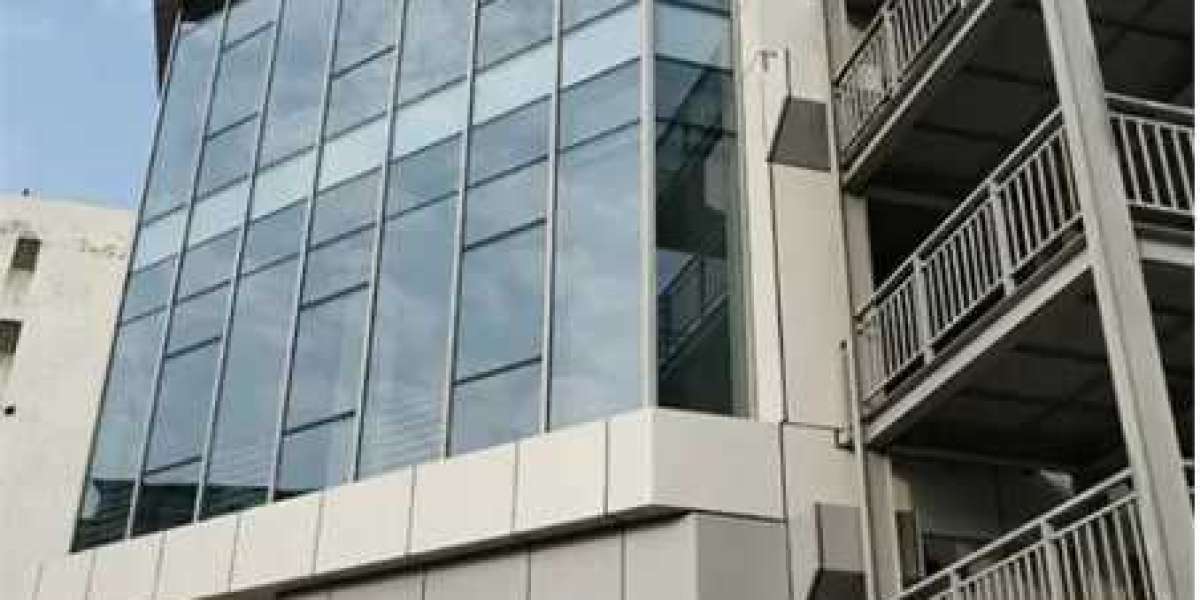Explore the world of aluminum veneer curtain walls in this insightful blog post. Discover the versatility, durability, and aesthetic appeal of these architectural elements. Learn about their sustainable features and how they enhance building functionality. Dive into the benefits of aluminum veneer curtain walls, from energy efficiency to design flexibility. Uncover the latest trends and innovations shaping the use of aluminum veneer curtain walls in modern construction projects. Stay informed about the practical applications and installation considerations for these cutting-edge building solutions.
Discover a wealth of information on aluminum veneer curtain walls that will expand your knowledge and inspire your next architectural endeavor.
Benefits of Aluminum Veneer
Aesthetics Enhancement
Aluminum veneer curtain walls elevate building aesthetics by offering a wide range of rich, long-lasting colors. The vibrant hues add a modern touch to structures, creating visually appealing facades that stand out.
The diversified appearances achieved through aluminum veneer allow architects and building owners to customize the look of their buildings. Whether aiming for a sleek, contemporary design or a more traditional aesthetic, the material offers design flexibility to bring their vision to life.
Design Flexibility
Architects benefit from the design flexibility provided by aluminum veneer curtain walls. This versatile material can be easily shaped and molded into various forms, allowing for innovative designs that push the boundaries of traditional architecture. The ability to experiment with different shapes and configurations gives architects the freedom to create unique and eye-catching structures.
Owners appreciate the easy processing capabilities of aluminum veneer, which simplifies the installation process and reduces construction time. The lightweight nature of the material makes it easier to handle and maneuver on-site, leading to quicker project completion times. Its durability ensures long-term performance, reducing maintenance costs over time.
Durability of Aluminum Curtain Walls
Material Properties
Aluminum curtain walls ensure durability through their inherent material properties. The use of aluminum, known for its strength and lightweight nature, contributes to the long-lasting performance of these structures. With a high strength-to-weight ratio, aluminum provides the necessary robustness without adding excessive weight to the building.
Aluminum's resistance to corrosion and weather conditions further enhances the durability of curtain walls. This resistance is crucial in maintaining the aesthetic appeal and structural integrity of buildings over time. By withstanding environmental factors such as rain, snow, and sunlight, aluminum curtain walls retain their quality and appearance for extended periods.
Structural Integrity
The structural integrity of aluminum curtain walls is a key factor in their long-term durability. These systems are designed to support the building's structure while providing an elegant facade. The combination of sturdy aluminum frames and high-quality installation ensures that curtain walls maintain their integrity even in challenging conditions.
Aluminum's lightweight nature makes it easier to install and handle during construction.
The flexibility of aluminum allows for various design possibilities, enhancing the aesthetic appeal of buildings.
Aluminum curtain walls can be customized to fit specific architectural requirements, offering versatility in design options.
Lightweight and Aesthetic Appeal
Energy Efficiency
Aluminum veneer curtain walls contribute significantly to energy conservation by enhancing energy efficiency in buildings. Their lightweight nature allows for better insulation, reducing the overall energy consumption needed for heating and cooling. This leads to lower energy bills and a more sustainable environmental impact.
Structural Load
The aluminum veneer curtain walls not only offer an aesthetically pleasing appearance but also play a crucial role in reducing the structural load on buildings. Despite being lightweight, they maintain exceptional strength, providing durability without compromising on performance. This balance ensures longevity and safety for the building occupants.
Modern Design
Incorporating aluminum veneer curtain walls into architectural designs adds a modern and sleek look to buildings. Their versatility allows for various customization options, enabling architects to create visually appealing facades that stand out. The clean lines and contemporary feel of these curtain walls enhance the overall aesthetic appeal of any structure.

Easy Maintenance of Aluminum Veneer
Minimal Upkeep
Aluminum veneer curtain walls require minimal upkeep to maintain their beauty over the long term. The material is designed to withstand various weather conditions without extensive maintenance.
Aluminum veneer's durability ensures it remains resistant to fading and deterioration, making it a popular choice for architectural projects that require longevity and low maintenance.
Cleaning and Maintenance
The aluminum veneer curtain wall is easy to clean, requiring simple regular maintenance to preserve its appearance. Routine cleaning with mild soap and water can help maintain the aesthetic appeal of the structure.
Regular inspections for any signs of damage or wear are essential to ensure the longevity of the aluminum veneer curtain wall. By addressing any issues promptly, property owners can prevent more significant problems in the future.
Design Versatility in Aluminum Veneer
Creative Possibilities
Aluminum veneer offers design versatility, allowing architects to create unique and innovative structures. The material's flexibility enables the implementation of intricate patterns and shapes.
Architects can play with textures, colors, and finishes to achieve a distinctive look for each project. This versatility opens up endless possibilities for creating visually stunning facades that stand out.
Complementary Building Styles
Aluminum veneer seamlessly complements a wide range of building styles and themes. Whether it's a modern skyscraper or a traditional building, the material can be tailored to suit any architectural vision.
The ability of aluminum veneer to blend in or contrast with different elements of a structure makes it a popular choice among architects seeking to achieve a harmonious design aesthetic.
Customization for Project Requirements
One of the key advantages of aluminum veneer is its customization capabilities. Architects can tailor the material to meet specific project requirements, whether it involves unique shapes, sizes, or finishes.
This level of customization ensures that each project is treated as distinct, allowing architects to bring their creative visions to life while meeting functional needs.
Installation Process Overview
Specialized Techniques
Aluminum veneer curtain wall installation involves specialized techniques to ensure a seamless process. Professionals must have expertise in handling the materials effectively.
The installation process demands attention to detail and precision to guarantee a flawless outcome. Workers need to follow specific steps meticulously.
Precision and Accuracy
Precision and accuracy are crucial during the installation of an aluminum veneer curtain wall. Each component must fit perfectly to achieve a cohesive appearance.
To maintain accuracy, measurements need to be precise, and cutting should be done with care to avoid errors.
Efficiency and Streamlining
Efficiency is key in the installation of aluminum veneer curtain walls. The process is streamlined to enhance productivity without compromising quality.

Key Steps for Installing Aluminum Veneer
Surface Preparation
To begin the installation of aluminum veneer curtain walls, the surface must be meticulously prepared. This involves cleaning the area thoroughly to remove any dirt, dust, or debris that could affect the adhesion of the panels. Proper surface preparation is crucial for ensuring a smooth and long-lasting installation.
It is essential to inspect the surface for any irregularities or damage that may need to be addressed before proceeding with the installation. Any imperfections in the surface can impact the overall appearance and performance of the aluminum veneer curtain wall. Once the surface is clean and free of defects, it is ready for the next step in the installation process.
Panel Securing
Securing the aluminum veneer panels effectively is paramount to ensure their stability and longevity. The panels should be attached using appropriate fastening methods that are suitable for the specific project requirements. This typically involves using screws or rivets to secure the panels to the underlying structure.
When securing the panels, it is important to follow manufacturer guidelines regarding spacing and placement to achieve optimal results. Improper fastening can lead to issues such as panel sagging, warping, or detachment over time. By using the correct fastening methods and ensuring a secure attachment, you can enhance the durability and aesthetics of the aluminum veneer curtain wall.
Alignment and Spacing
Achieving precise alignment and spacing between aluminum veneer panels is essential for creating a visually appealing and cohesive finish. Careful attention should be paid to ensure that each panel is positioned correctly relative to its neighbors, maintaining consistent spacing throughout the installation.
Proper alignment not only enhances the aesthetic appeal of the curtain wall but also helps maintain structural integrity. Misaligned panels can create gaps or overlaps that compromise both visual appeal and weather resistance. By taking care to align and space each panel accurately during installation, you can achieve a seamless look that enhances the overall appearance of the building facade.
Considerations in Choosing Aluminum Veneer
Project Requirements
When selecting aluminum veneer, it's crucial to evaluate the project requirements thoroughly. Factors such as building height, location, and purpose play a significant role. Understanding the project's scope ensures the veneer meets structural needs and design expectations.
Design Preferences
Design preferences are key when choosing aluminum veneer. Architects and designers must consider the desired aesthetic appeal, whether it's a modern, sleek look or a more traditional appearance. The veneer should complement the overall design scheme while providing functionality.
Environmental Factors
Environmental considerations are vital in selecting aluminum veneer for a curtain wall. Assessing factors like exposure to sunlight, wind loads, and temperature variations is essential. Opting for a high-quality veneer that can withstand harsh weather conditions ensures longevity and performance.
Building Regulations
Adhering to building regulations is non-negotiable when installing an aluminum veneer curtain wall. Compliance with local codes and standards guarantees safety and structural integrity. Failure to meet these regulations can result in costly revisions or even legal issues down the line.
Thickness Selection
Choosing the right thickness of the aluminum veneer is critical for its performance and durability. Thicker panels offer more strength and rigidity, suitable for high-rise buildings or areas prone to extreme weather conditions. Thinner panels may be suitable for low-rise structures with minimal exposure.
Finish Options
Selecting the appropriate finish for the aluminum veneer impacts both aesthetics and maintenance requirements. Options such as anodized finishes provide durability against corrosion, while powder-coated finishes offer a wide range of colors for design flexibility. Considering long-term maintenance needs is crucial in choosing the right finish.
Exploring Design Options for Aluminum Veneer
Panel Shapes
Experiment with various panel shapes such as rectangular, square, or even custom shapes to create visual interest. Different panel shapes can add a dynamic and modern touch to the aluminum veneer curtain wall.
Color Combinations
Mix and match color combinations to achieve a desired aesthetic. Consider combining bold colors with neutral tones for a striking contrast. Utilizing contrasting colors can enhance the overall appearance of the building facade.
Textures and Finishes
Incorporate textures and finishes to add depth and character to the aluminum veneer curtain wall. Matte, glossy, or textured finishes can create visual intrigue and make the facade more visually appealing. Experimenting with different textures can elevate the design to new heights.
Installation Patterns
Explore innovative installation patterns to give the aluminum veneer curtain wall a unique look. Consider staggered panel layouts, geometric arrangements, or asymmetrical designs for a contemporary feel. Innovative installation patterns can set the building apart and make a bold architectural statement.

Final Remarks
The benefits of aluminum veneer in curtain walls are undeniable. Its durability, lightweight nature, and design versatility make it a top choice for architects and builders alike. The easy maintenance and installation process further enhance its appeal, offering a seamless solution for modern construction projects. Considering the various design options available, aluminum veneer curtain walls provide a winning combination of aesthetics and functionality.
Exploring the world of aluminum veneer curtain walls opens up a realm of possibilities for innovative architectural designs. Whether embarking on a new project or renovating an existing structure, considering aluminum veneer can elevate the building's appearance while ensuring long-lasting performance. Embracing this versatile material not only enhances the visual appeal but also underscores a commitment to quality and sustainability in construction practices.
Frequently Asked Questions
What are the benefits of using aluminum veneer in curtain walls?
Aluminum veneer offers durability, lightweight construction, easy maintenance, design versatility, and aesthetic appeal, making it a popular choice for modern architectural projects.
How durable are aluminum curtain walls?
Aluminum curtain walls are highly durable, providing long-lasting performance against weather elements and structural stresses while maintaining their appearance over time.
Is aluminum veneer suitable for buildings with specific design requirements?
Yes, aluminum veneer offers design versatility, allowing architects to customize the appearance and shape of the curtain wall to meet specific aesthetic and functional requirements.
What is the installation process like for aluminum veneer curtain walls?
The installation process involves key steps such as surface preparation, panel layout, attachment system installation, panel fixing, and finishing touches to ensure a secure and visually appealing result.
What factors should be considered when choosing aluminum veneer for a project?
Considerations include budget constraints, desired aesthetics, building location and environment, maintenance requirements, as well as compliance with local building codes and regulations.







